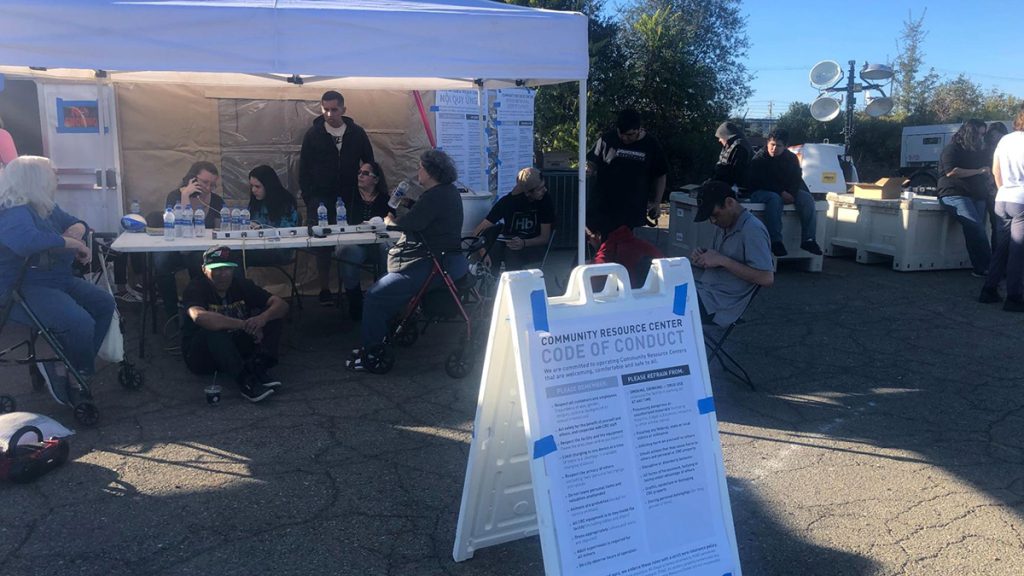
Mendocino County residents gather in Ukiah to charge their phones and connect to wifi at a community resource center set up by PG&E during a week long blackout during October 2019 | Photo: Kate B. Maxwell
Building your newsroom’s emergency source list, map, and connections
How will you get information during a disaster?
For newsrooms preparing to cover emergencies, there are a range of material and operational considerations to examine such as necessary equipment, staff support and schedules, and how to stay safe in the middle of a disaster. Planning the practical ways you will communicate with each other and community members, and how to get crucial information out to the people who need it, is an essential part of preparing your newsroom and your community for an emergency.
A communications “go bag” can be a vital part of making sure your newsroom has a shared emergency source list and ma. Putting together necessary information and documents are an important exercise in themselves, in order to identify existing gaps in your newsroom’s sources and resources, policies, operations infrastructure, and role in your community’s larger ecosystem.
Do you know:
- How to provide timely information in a disaster
- Who in your area is responsible for issuing evacuation orders
- How to provide mental health resources for your staff
Taking the time now to assess what resources are available, and what gaps you want to try and fill, are crucial to help you make a multitude of decisions in the middle of an emergency.
While it’s essential to be able to respond to different situations and remain flexible as different emergency needs might arise, it’s also true that existing relationships and networks are the best ways to connect with people as they navigate stressful and rapidly changing situations.
That’s why local newsrooms and journalists who already have these connections are best equipped to serve as part of an emergency response information network, and as a communications bridge between officials and response agencies, readers, community groups, and a broader audience during disasters. Addressing these questions and assembling informational resources can help you build those relationships and develop editorial contacts and guidelines your staff can refer to during and after emergencies.
How you will communicate: A communications “go bag”
To start, each newsroom and reporter should have access to basic information about how to communicate with staff, sources, and the community during emergencies. This information should be available in hardcopy as well as shared digital documents, so that it can be accessed, shared, and updated as needed.
This will require a larger conversation and/or a newsroom manager to put together an emergency operations plan. This should involve strategies to organize coverage, access available resources, emergency verification and publishing workflows, and determine what levels of information access and decision making should occur during different disaster scenarios — such as sharing publishing passwords or purchasing supplies, and when/where staff should meet.
Managers will need to assess what information needs to be kept internal and how to best ensure staff privacy is protected while also making important details accessible.
At a minimum, a communications go bag should include:
- Newsroom emergency contracts and phone tree
- Press passes, business cards or other documents verifying newsroom affiliation
- Legal contacts and codes applicable to accessing disaster areas
- Relevant HR, insurance, and physical/mental health policies with connections to resources for staff if possible
- Passwords/contacts for emergency access for publishing to platforms or access to social media as per emergency operations/publishing plan
- Contact info for all staff and support personnel, including multiple contact options such as personal phone numbers, social media accounts and emergency contacts
- Relevant information about: medical and access needs, home connectivity and location, next of kin/family, vehicles (4WD) and mobility needs etc.
- Additional editorial or operations contacts that may be important — translators, photographers, off-site editors, web developers, translators, or other people who can assist with operations remotely as per emergency plan
- Emergency source list (see below)
- Emergency info map (see below)
How you will get information: Emergency source list and map
Each newsroom should have a shared source list of emergency information sources, as well as a map. Your newsroom may already have a version of this but identifying what agencies, officials, community organizations and leaders, and specific infrastructure might be important during a disaster can also allow you to develop relationships with people and find sources who can help verify information or share valuable insight, as well as identify editorial coverage that will be useful to your readers to help them prepare.
It can be very difficult to identify new sources and find ways to contact them once an emergency is underway, and these connections can be crucial for clarifying or verifying facts during a disaster.
For both your emergency source list and map, you will start with government agencies or official infrastructure. You should also include sources and locations of unofficial community importance such as community groups and both public and online gathering places where it’s likely that people will seek out information and resources, and relevant experts/ important community contacts. Particularly during power outages or when other communications infrastructure isn’t working, people are likely to seek out existing relationships and community organizations or local businesses will often fill in the needs that official sources aren’t addressing. Your list should include contact information for other local media, in case collaborating or checking information is important.
When possible, it is useful to have multiple different contacts for different organizations, such as agencies involved in emergency response, especially in situations where the media contact may not be in the field, or be based in another location. For example, when a wildfire is underway, there might be significant delays in information from the battalion chief in the field — and it may be crucial to be able to verify where exactly the spread of the fire is now, or clarify what area might be facing the next round of evacuations.
On your map, you should not only include information such as official shelters, infrastructure, or community gathering places, but also include places that might be useful for staff, such as locations that have public wifi available, emergency evacuation routes, newsroom equipment storage, gas stations, or other locations that your staff might need to reference during a disaster.
As with other emergency information, make sure to keep this shared, updated, and with multiple physical and digital copies stored in different places. You may also want to consider putting together a version of this information for your readers, as a way to guide them directly to official information sources during emergencies — here’s an example of The Mendocino Voice’s wildfire and winter weather info guide.
Your emergency source list and map should:
- Identify information for multiple contact people when possible: press contact plus on the ground contacts; consider areas and communities adjacent your typical coverage area that might not have other news sources or that you may want to reach
- Identify official public and media emergency communications channels — how they will share information with the public now, and how they share information in an emergency — keeping in mind this may be a patchwork of different agencies and there may be different people, platforms, and policies once an emergency is underway
- Include official emergency operations plans, policies and processes, including: evacuation routes and shelters, emergency notification systems, and how agencies might be coordinating with each other, residents, and media
- Identify important local data sets to reference, or that you may want to track
Information to include: Emergency response and agency contacts for local, state and federal agencies and officials including those involved with:
- Weather and environmental emergencies including fires, flooding, hurricanes, tornadoes, winter storms, heat waves, drought, air or water quality
- Public health or infrastructure emergencies such as hazardous materials responders, utilities and communications equipment, water sources, law enforcement, and other emergency response agencies
- Transportation agencies, centers (such as ports and airports) and emergency routes
- Hospitals and medical clinics, libraries, schools, jails and prisons
- Social services and housing agencies, including those focused on the elderly, youth disabled, or low income residents, other community services contacts
- Community centers serving a variety of different communities, homeless shelters, religious centers, food banks, and other active volunteer or mutual aid groups
- Locations that may have public wifi, satellite internet, backup power, or other community resources, which could include local businesses
- Home and work locations of relevant newsroom staff
- Locations useful for staff: in-the-field reporting (see above) or as workplaces/shelter or resources, such as gas stations or access routes
- Other local and community media partners for collaboration
- relevant experts, researchers, academics, or other community leaders
- relevant community information sources such as social media groups, or specific communities such as the farm bureau or arts council
Identifying how to get emergency information, who might be involved in different kinds of disaster and community response, and building these relationships in advance is key to making sure your staff and community can stay safe, and get accurate and reliable information even when communications infrastructure or conditions are changing quickly. Introducing yourself and learning about the disaster plans currently in place, connecting with sources, as well as identifying what ways people are currently getting their info, will allow you and your readers to be engaged and prepared to respond when needed.

Comments